DUBAI: As the coronation of King Charles III got underway in the UK, viewers around the world were firmly focused on the pageantry as well as the fashion.
As historic coronation attire — such as crimson robes, ermine capes, and fur-trimmed red-velvet cornets — filled Westminster Abbey in London, the UK’s royal family championed British designers while Arab royals also put on a show.
King Charles arrived at Westminster Abbey in royal ermine over George VI’s crimson Robe of State - conserved by royal restorers Ede & Ravenscroft and the Royal School of Needlework - and changed into George VI’s purple Robe of Estate to leave the Abbey.

During the crowning ceremony, King Charles was given a shimmering gold-sleeved coat to wear called the Supertunica that was created for George V in 1911 and has been worn at coronations, including by the Queen Elizabeth II. (Getty Images)
During the crowning ceremony, he was given a shimmering gold-sleeved coat to wear called the Supertunica that was created for George V in 1911 and has been worn at coronations, including by the Queen Elizabeth II. The 2kg garment is made of cloth of gold — silk thread wrapped in thin pieces of gold or silver gilt metal — with Arabesque and floral motifs.
On top of the Supertunica, the king wore a floor-length cloak called the Imperial Mantle, which was made in 1821.
Made of cloth of gold, it is embellished with fleur-de-lis, imperial eagles, and national floral emblems of red-pink roses, blue thistles and green shamrocks. It is designed to symbolise the divine nature of kingship.
The king reused a sword belt from 1937 worn by his grandfather, also known as the Coronation Girdle. It is made of embroidered cloth of gold and boasts a gold buckle stamped with national emblems. The single coronation glove, also known as the Coronation Gauntlet, was placed on the king’s right hand in which he held the Sovereign’s Sceptre with Cross during the crowning.
The garments are usually kept in the Tower of London.
The historic St Edward’s Crown was then placed on King Charles III’s head — it was worn for less than one hour before being stored away again in the Tower of London.
Made of 22-carat gold, the 360-year-old crown is more than 30cm tall and weighs just over 2kg. The crown features a gold frame with double arches and is set with rubies, topaz, sapphires, and garnets.
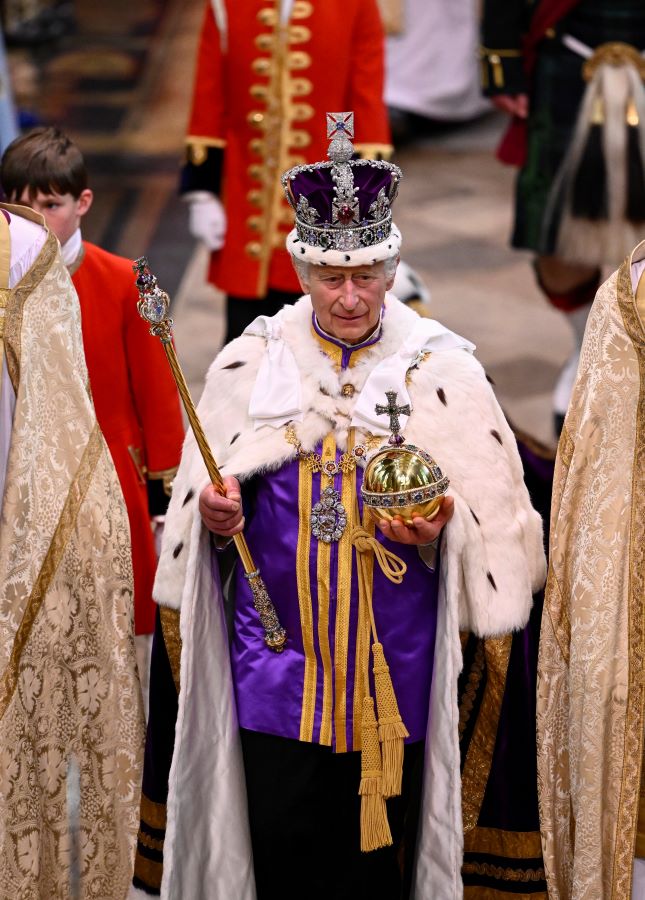
The Imperial State Crown, made in 1937, was worn by the king after the ceremony as he made his way to Buckingham Palace. (Getty Images)
The Imperial State Crown, made in 1937, was worn by the king after the ceremony as he made his way to Buckingham Palace. It has gold framing instead of a fur trim and is mounted with three large stones, including the Cullinan II diamond, while the complementary stones include 2,868 diamonds that appear in silver mounts and colored stones that appear in gold mounts. In addition, 17 sapphires, 11 emeralds, and 269 pearls also feature on the crown.
For her part, Queen Consort Camilla was crowned with Queen Mary’s crown, which was worn by Queen Mary at the coronation of her husband, George V, in 1911 and consists of 2,200 diamonds and the Cullinan III, IV and V diamonds.

Queen Consort Camilla is wearing the coronation necklace made by Garrard for Queen Victoria and given to her in 1858. (Getty Images)
She also wore the coronation necklace made by Garrard for Queen Victoria and given to her in 1858.
It features 25 graduated brilliant diamonds with a 22.48 carat diamond pendant, known as the Lahore Diamond. The necklace was worn by several queen consorts: Queen Alexandra in 1902, Queen Mary in 1911 and Queen Elizabeth, later the Queen Mother, in 1937.
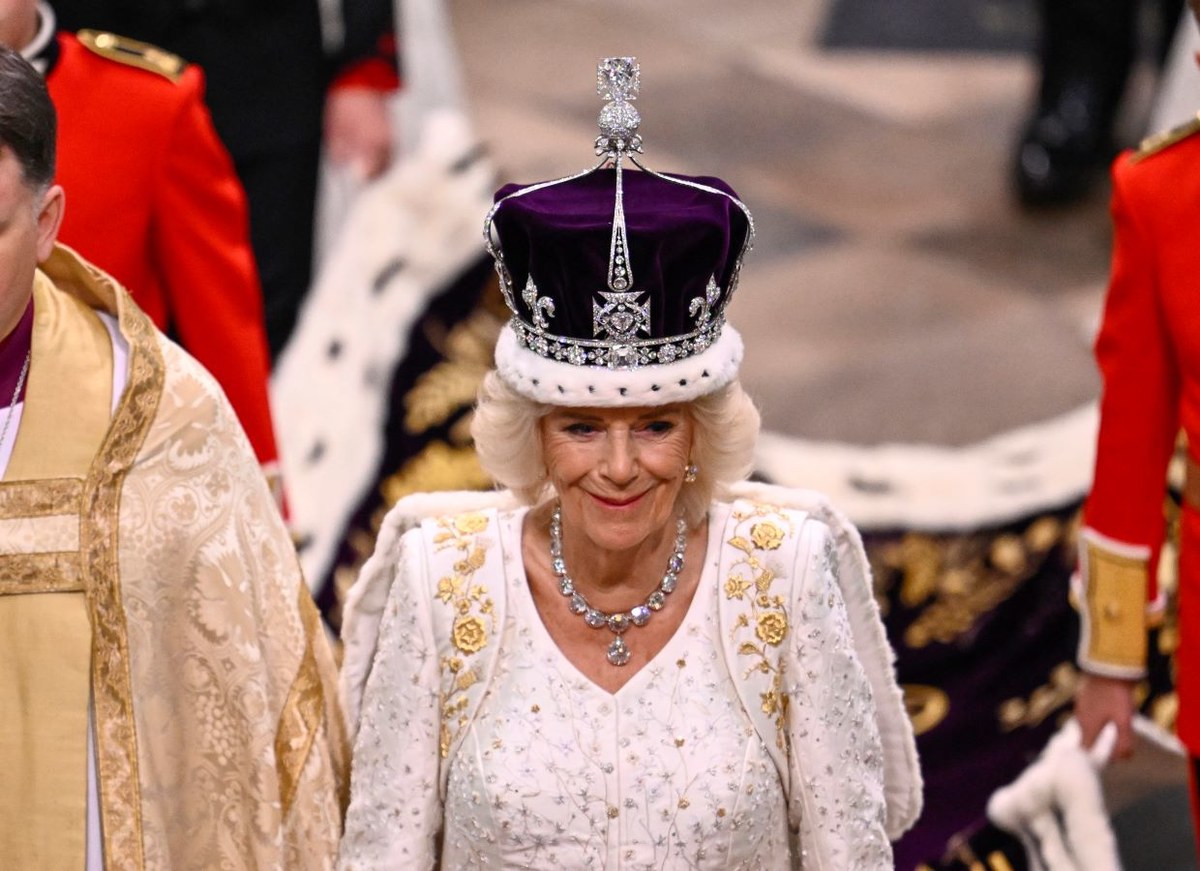
Queen Camilla is wearing a white, floor-length ensemble with gold embroidery designed by Bruce Oldfield, OBE, a British fashion designer best known for his couture occasionwear. (Getty Images)
The royal wore a white, floor-length ensemble with gold embroidery designed by Bruce Oldfield, OBE, a British fashion designer best known for his couture occasionwear. Not only has Oldfield maintained a close working relationship with Queen Camilla, but he also designed looks for the late Princess Diana while she was married to then-Prince Charles.

Princess of Wales Kate Middleton arrived at Westminster Abbey wearing a formal robe and mantel – reportedly at the request of King Charles and Queen Camilla – worn over an Alexander McQueen dress in ivory silk crepe with silver bullion and thread work embroidery, featuring rose, thistle, daffodil and shamrock motifs. (AFP)
Meanwhile, Princess of Wales Kate Middleton arrived at Westminster Abbey wearing a formal robe and mantel – reportedly at the request of King Charles and Queen Camilla – worn over an Alexander McQueen dress in ivory silk crepe with silver bullion and thread work embroidery, featuring rose, thistle, daffodil and shamrock motifs. The fashion label’s creative director Sarah Burton also designed her wedding gown in 2011.
The Princess of Wales was also wearing a glittering floral headpiece, not a tiara.
The head topper is a Jess Collet x Alexander McQueen creation and consisted of shimmering silver bullion, crystal, and silver thread leaf embroidery.
Adding to the stunning jewellery were pearl and diamond earrings that belonged to her late mother-in-law, Princess Diana. She also wore the George VI Festoon Necklace, a piece made in 1950 at the request of King George VI for his daughter Princess Elizabeth (later Queen Elizabeth II).
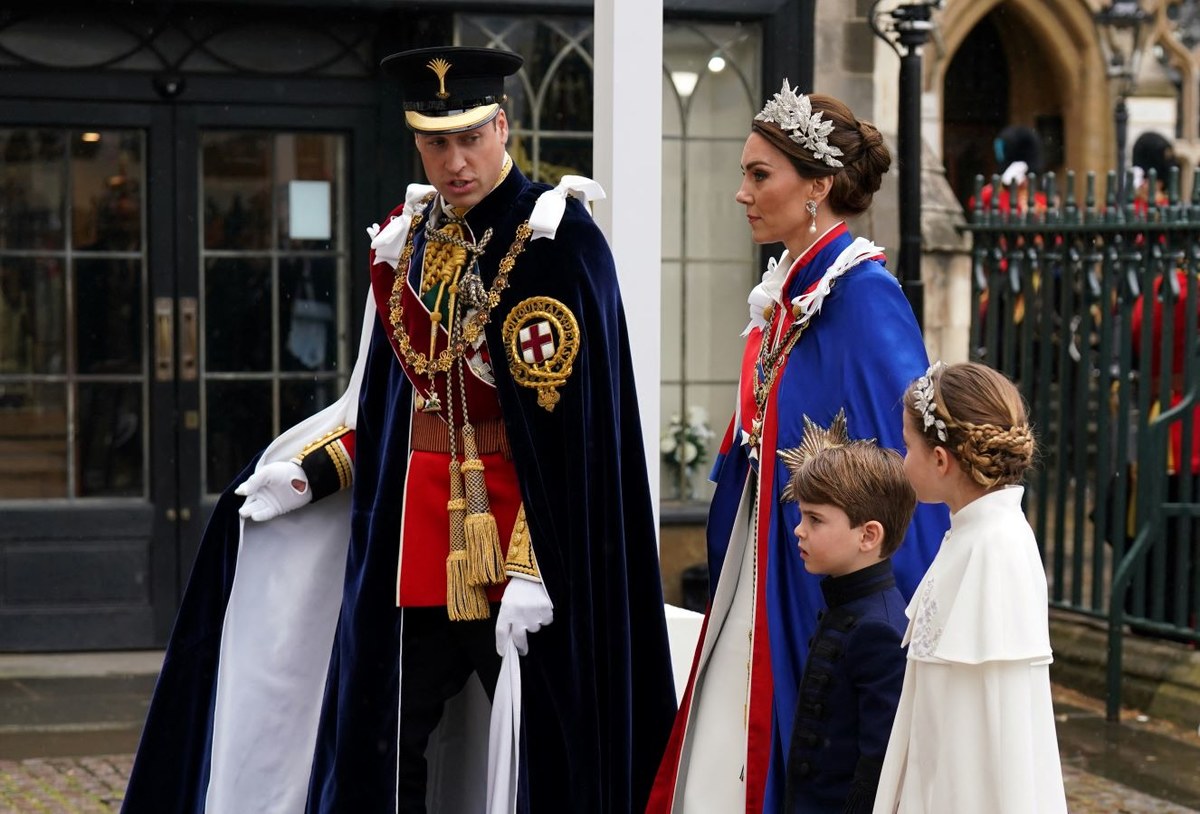
Prince William, seen beside Princess Kate, wore formal robes and mantels over the ceremonial dress uniform of the Welsh Guards, again at the request of King Charles and Queen Camilla. (AFP)
Prince William, seen beside Princess Kate, wore formal robes and mantels over the ceremonial dress uniform of the Welsh Guards, again at the request of King Charles and Queen Camilla.
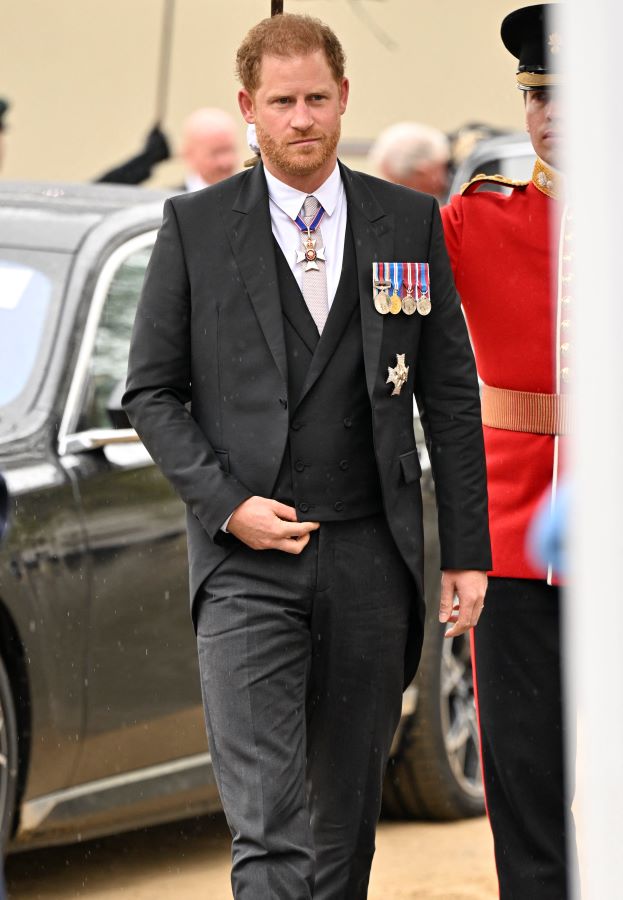
Prince Harry, the Duke of Sussex, on the other hand, wore a black three-piece set of tails and military medals on his chest. (AFP)
Prince Harry, the Duke of Sussex, on the other hand, wore a black three-piece set of tails and military medals on his chest, and had no formal role at the event.
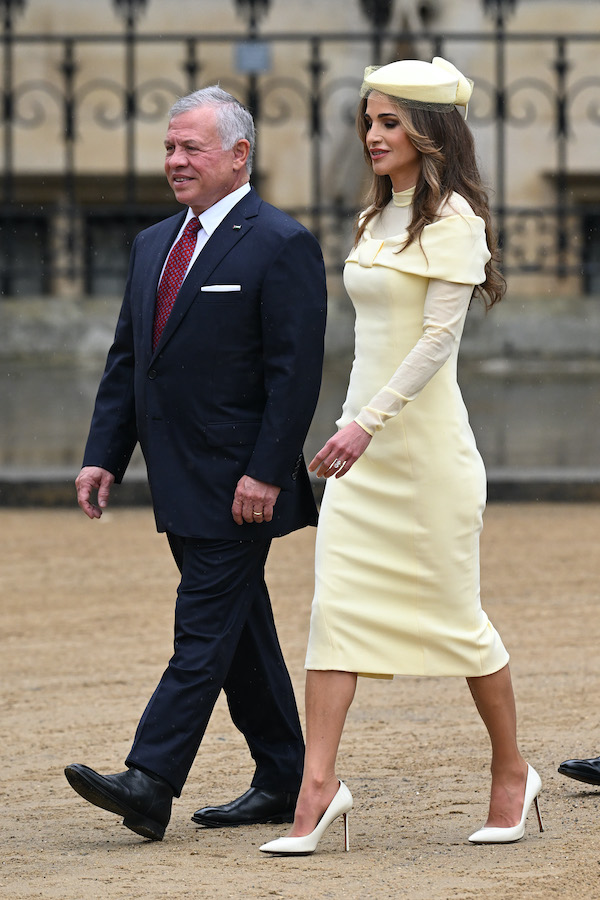
Queen Rania attended the coronation in a cream-colored pencil dress. (Getty Images)
Jordan’s Queen Rania attended the coronation in a custom-made pastel lemon yellow silk crepe pencil dress by Australian designer Tamara Ralph with a bow-like design around her shoulders and sheer sleeves. She wore a matching hat, in line with the day’s eschewing of tiaras, the Knot Intrecciato Leather Clutch by Italian luxury label Bottega Veneta and Jimmy Choo Romy Pumps in white.
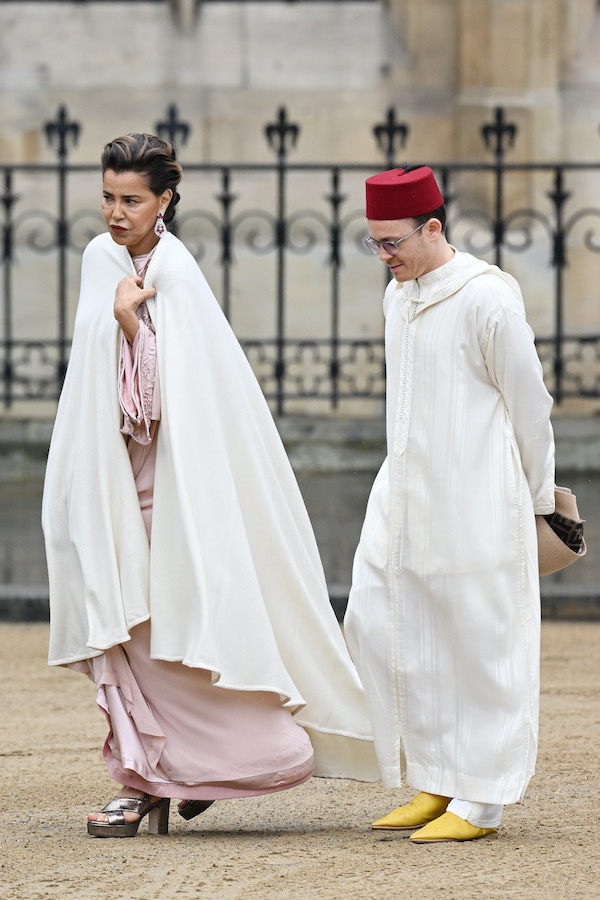
Princess Lalla Meryem of Morocco arrived wearing a lilac-colored traditional dress with a white cape wrapped around her shoulders. (Getty Images)
Princess Lalla Meryem of Morocco — the daughter of the late King Hassan II — arrived wearing a lilac-colored traditional dress with a white cape wrapped around her shoulders. She accessorized her look with glitzy pear-shaped earrings.
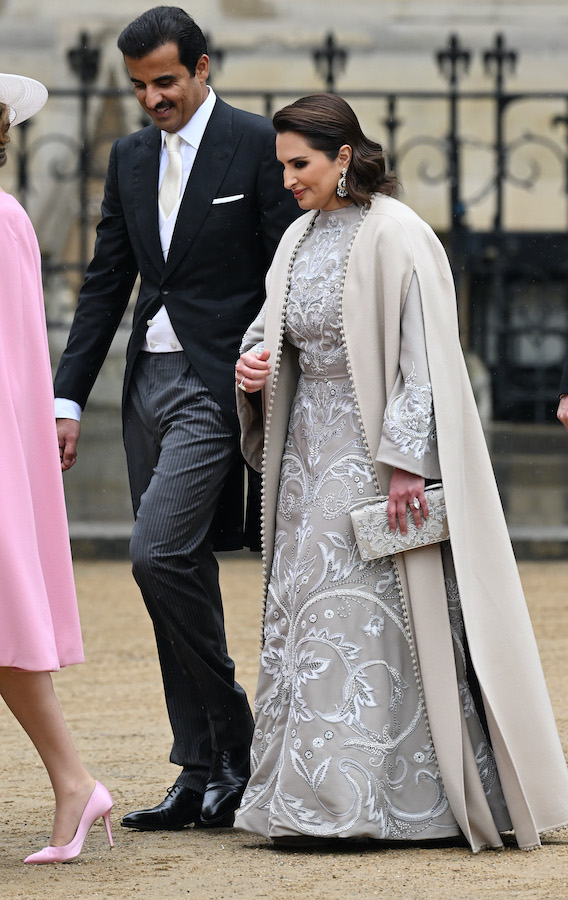
Qatari royal Sheikha Jawaher bint Hamad bin Suhaim Al-Thani wore a grey heavily embroidered long-sleeved gown. (Getty Images)
Qatari royal Sheikha Jawaher bint Hamad bin Suhaim Al-Thani, the wife and consort of the Emir of Qatar Tamim bin Hamad Al-Thani, was also in attendance. She wore a grey heavily embroidered long-sleeved gown from Dior’s Fall/Winter 2022 Couture collection and an off-white floor-length cape.

US singer Katy Perry, who will perform at the coronation concert in Windsor on Sunday, was dressed in a fitted lilac short-sleeved skirt suit by British label Vivienne Westwood with matching opera gloves and statement hat. (AFP)
Among the celebrity guests were actress Emma Thompson in an Emilia Wickstead red coat adorned with rose designs and US singer Katy Perry, who will perform at the coronation concert in Windsor on Sunday, dressed in a fitted lilac short-sleeved skirt suit by British label Vivienne Westwood with matching opera gloves and statement hat.
Veteran actresses Maggie Smith and Judi Dench, who has portrayed both Queen Elizabeth I and Queen Victoria on screen, chose different shades of blue, while US singer Lionel Richie opted for Esclot London attire.


























